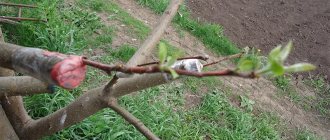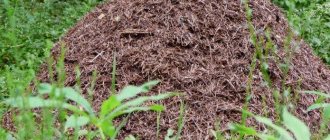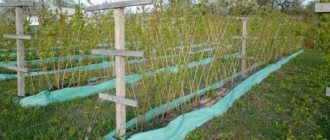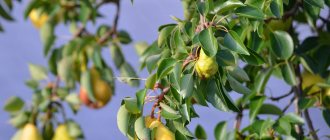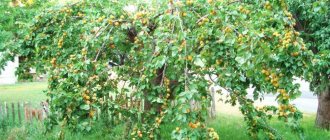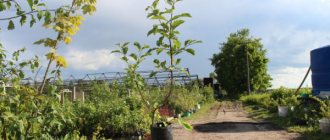Many gardeners practice autumn planting of berry bushes; this approach has its advantages. But you can plant raspberries in the spring. The main thing is to respect the deadlines and use suitable planting methods.
We'll tell you how you can plant raspberries in the spring and what planting methods are best to use. Let's talk about the optimal timing and features of work in different regions.
Methods for planting raspberries
There are a great many ways to plant raspberries and the choice depends on the personal desires of the gardener. Some people don’t want to spend a long time preparing the berries for planting, while others are ready to spend a lot of time on it. Therefore, you can plant seedlings or cuttings.
The main difference between a cutting and a seedling is that a seedling has roots, while a cutting is just a cut shoot. To plant a cutting, you need to spend a lot of time on it. The seedling is planted practically unchanged and minimal time is spent on planting.
Bush planting method
If raspberries are planted using the bush method, then the gap between each bush should be about 1.5 m. The depth of the hole in which the bush will be located should be 50 cm, and the width should be 45-60 cm. Before planting, add fertilizer to each hole:
- 4 kg of compost or humus;
- 40 g ash;
- 12-20 g of saltpeter;
- 40 g superphosphates.
After applying the fertilizer, the soil must be mixed so that it is distributed evenly. Then place the bush in the hole. When planting, shake the seedling a little, which will help fill the interroot space with soil.
The bush cannot be driven deep into the soil, otherwise its development will be very slow. But you can’t plant the bush on the surface, as the root buds will dry out. You need to remember to water the bush and compact the soil. Planting should be done so that the root collar is at ground level.
In winter, raspberries need to be bent down. You can bend down each shoot or the whole bush. Press down the raspberries with something heavy, but in no case with stones or earth. The layer of snow in winter should not be less than 50 cm, otherwise the bush will simply freeze and die.
Landing in trenches
This method of planting raspberries differs from the previous one in that it is more labor-intensive. The gardener will need to spend more time on planting, but the result will not be long in coming.
Before planting berries, you need to do some preliminary work with the soil:
- Clear the area of weeds.
- Mark the plantings.
- Dig trenches up to 45 cm deep and 60 cm wide.
- Leave 120-160 cm between rows. This indicator depends on the development characteristics of the berry variety.
- Place a nutrient cushion of organic materials up to 10 cm thick at the bottom of the trench. It will feed and warm the raspberry tree.
- Place soil on top of the pillow, which will help prevent rotting in the future.
In this video, the gardener talks about planting raspberries in a trench:
It is better to determine a sunny area under the trench, direction from north to south. In such conditions, the berries can quickly take root and produce a large harvest.
It is best if two people plant raspberries in trenches. One will hold the bush, the second will dig it in with earth.
Also, planting raspberries consists of the following steps:
- Spread out the roots of the bush.
- Water the raspberries and cover them with soil.
- Seal the top layer of mail.
- It is important to maintain the planting depth - do not bury the seedling, but do not leave it on the surface.
- Reinforce the edges of the trench with sides so that the earth will not crumble.
- Install T-shaped supports at the end of the trench; they will help the bushes not fall to the ground.
- Stretch the wire in two rows between the supports.
Before winter, raspberries also need to be prepared - bend the entire trench together, and not each bush separately.
Raspberries, like other shrubs, can be planted either in autumn or spring. The choice of season depends on the personal desires of the gardener. For raspberries, as for other fruit and berry bushes, the best season is autumn. It will ensure raspberries bloom in the spring and the harvest will be in the summer. But this opportunity is not always available, and raspberries are often planted in the spring. This planting method has its certain pros and cons.
Planting a seedling
First of all, you need to choose a seedling. When choosing a seedling, pay attention to how its roots are developed. After purchasing, if you do not plant it immediately, then place it in water. For transportation you need to use a wet cloth and a bag. This will help retain moisture and the seedling will remain alive during the move.
It is best to use annual shoots for planting, cut to 30-40 cm. The seedling is immediately placed in the ground and watered. You don't need to do anything else.
Watch a video review of planting raspberry seedlings in spring below:
Planting a cutting
If a gardener decides to plant raspberry cuttings, then he must make a choice between root cuttings and green ones. Root cuttings are used if the stems of the plant are damaged by something. Raspberry diseases rarely spread to the roots and therefore they can be used for propagation.
In spring or autumn, dig out the adventitious root as carefully as possible. It is best if several branches remain on it. Cut all healthy roots into pieces 8-10 cm long.
Raspberries can also be propagated from green cuttings if the bush is sick with something. To propagate by green cuttings, choose root suckers that were cut off during thinning of the bush. These should be shoots up to 15 cm high with preserved leaves.
Soil preparation
Only light and rich soils are suitable for planting raspberries. Soil preparation includes various activities:
- digging to a depth of at least a spade bayonet;
- filling with humus, manure, chemical fertilizers;
- clearing the area of weeds;
- mulching with peat, compost, pine needles of new plantations.
If raspberry seedlings are planted using the strip method, then fertilizers are scattered over the bed and dug into the soil. For 1 sq. m. pour 2 buckets of organic fertilizers: high-moor peat, humus, compost, and one glass of nitroammophoska or any fertilizers with microelements. With the nesting method, fertilizers are poured into the prepared hole when planting.
If you do not want to use mineral fertilizers, the rate of natural organic fertilizers is doubled and half a liter of ash is added per 1 square meter. m. Unprocessed organic matter contains various fungal and bacterial infections. A high concentration of nutrients can burn the roots.
Therefore, fresh organic matter is added to the garden bed two months before planting the seedlings.
On light soils with a high content of granular components, the bushes grow well in height and width. In addition, on such soil you can get many offspring and replacement shoots. Light soil provides oxygen and water access to the roots.
The presence of mulch helps solve a number of problems on the plantation:
- stops overgrowing by weeds;
- prevents the soil from drying out;
- preserves the porous structure of the soil, which creates conditions for breathability;
- ensures the existence of beneficial microflora;
- gradually turns into fertile humus.
Important! The mulch layer should be high, at least 8-10 cm. Straw, pine litter, and peat will do.
Pros and cons of spring planting raspberries
The advantages of such a landing include the following factors:
- After winter, the soil is saturated with minerals and the bush will quickly form roots.
- A good helper for young roots will be soil saturated with melt water.
- The bush can hardly be watered; the soil is saturated with moisture after winter.
- Many pests in the spring just wake up from sleep and are unable to damage the berries.
- When summer comes, the roots will be firmly rooted in the ground and will be able to safely survive the hot days.
The main disadvantage of planting raspberries in the spring is that the bush will not bear fruit the year it is planted. The first berries will appear only after a year.
Further care
Caring for raspberries is as follows:
- After planting, the seedlings are shortened to 15-25 cm, unless they have been trimmed by the seller. Without this procedure, the plant will spend all its energy on growing green mass, which will lead to depletion of the rhizome. Replacement buds do not form on the roots, from which young shoots should appear in the new season.
- The tree trunk circle is mulched with hay, mown grass, peat, and sawdust. The layer height is 5-7 cm. This prevents the appearance of a dry earthen crust, which slows down the penetration of moisture and nutrients. Mulch inhibits the growth of weeds and acts as an organic fertilizer.
- Raspberries, especially remontant ones, love moisture , so one of the main tasks of the gardener is to provide it with regular, abundant watering. To maintain an optimal moisture level, it is recommended to install a drip irrigation system, and on particularly hot days, arrange sprinkling.
- If you follow the recommendations for fertilizing the soil when planting, you do not need to feed raspberries in the next 2-3 years. Next, organic matter (wood ash, humus) and potassium-phosphorus fertilizers are added to the soil.
- In the fall after harvest or in early spring, bushes are pruned. The main work is carried out in the fall, and in the spring - sanitary pruning.
- To limit the growth of shrubs and keep maintenance procedures to a minimum, it is recommended to bury slate sheets, roofing iron or any other similar material to a depth of 0.5 m between the rows.
- In regions with a harsh climate, the bushes are tilted towards each other and tied so that frost does not damage the shoots. Tarpaulin or agrofibre is used as a covering material.
- If the raspberries are planted as bushes, the shoots are tied in a fan-shaped manner so that they do not break under the weight of the fruit. To do this, two pegs are driven between the bushes, to which shoots of neighboring bushes are tied at different heights. When planting using the tape method, a trellis garter is used: several rows of wire are tied to the supports and the shoots are fixed so that they are positioned at a slight slope.
- The first spring treatment against pests is carried out after the shoots have grown to a height of 15 cm. For spraying, a solution of “Karbofos” or colloidal sulfur, an infusion of tansy, garlic, and onion peels are used.
Step-by-step instruction
If a gardener decides to plant raspberries in the spring, all stages of planting must be carried out correctly. Only in this case will the bush take root and produce a large harvest.
Selection and preparation of seedlings
The first stage is the most important, since the future growth of the berry will depend on the source material. The best option for planting is a bushy seedling with well-developed roots. It is this kind of seedling that will be able to establish itself very well in the ground the first time.
It is important to pay attention to the root. There should be no dry parts on it that break very easily. The buds on the seedling must be fresh, without dry parts, then the raspberries can quickly take root. Sometimes a plant with dry buds takes root, but this is an exception to the rule and does not need to be followed.
Ideal time to plant
It is best to plant raspberries in natural soil in the first spring months. The ideal time is late March or early April. At this time, frosts are rare and the soil is well saturated with organic matter and moisture. Raspberries planted during this period will grow well and quickly form a root system.
Landing place
The place on the site where raspberries will grow must have certain criteria:
- Plant the raspberries so that they receive as much light as possible.
- The future shrub should be located in a place well protected from the wind.
- Raspberries should always have access to fresh moisture, so do not plant raspberries in areas full of groundwater. Stagnant water should not fall on the roots.
- Do not plant raspberries near currants. It has well-developed roots and will take some of the nutrients from the raspberries.
- Plant the berries in the direction from north to south, then the bush will evenly receive all the nutrients.
If the location does not have all of the above criteria, then the raspberries will grow, but the berries may be less aromatic and not very juicy.
Distance between seedlings
It is very important to control the distance between the bushes - at least 50 cm. But do not plant the bushes very far from each other, this will be inconvenient for further use of the bush.
Raspberries planted at a distance of 50 cm develop evenly. The bushes will not compete with each other. This distance is also convenient for gardeners; they can walk freely between the bushes and loosen the soil or harvest.
Soil preparation
For raspberries, as for other fruit and berry bushes, it is very important in what soil the plant will grow. Light soils are best. As a rule, they are very rich in minerals. If there is no such land on the site, the soil will need to be fed with various fertilizers more than light soils.
It is best to prepare the soil in the fall, which will shorten the planting time in the spring. Weeds must be removed and fertilizers applied. Level the ground and leave it until spring. In such soil the bush can quickly take root.
Well preparation
Instead of digging up the entire area, you can prepare individual holes for each bush in the fall. Each hole will eventually contain a raspberry bush, and they will not interfere with each other. The dimensions of the hole - depth and diameter should be 50 cm. If the hole is square, then the sides should also be 50 cm.
Remove the soil from the hole, mix it with fertilizers and return it back to the hole. Do not compact the soil under any circumstances. Leave it until spring, the young bushes will grow well in this hole and fill it entirely with their roots.
Top dressing
An equally important element in planting raspberries is fertilizer. They will affect the future growth of the berry. First of all, you need to put about 4 kg of compost on the bottom of the hole. Raspberries also need to be fertilized:
- 50 g superphosphate;
- a glass of wood ash;
- 30-50 g of nitrogen fertilizers;
- 3 kg manure
Fertilizing is needed even in cases where the soil is fertile. If the fertile soil is not fed, the bush will grow large, but there will be few berries. It is fertilizers that can affect the taste of the crop and the size of the bush.
Where can you plant raspberries?
There is no consensus among gardeners about the best place to plant raspberries: some choose sunny places, others prefer partial shade. It is known that the following points are important for the plant:
- possibility of systematic watering;
- lack of stagnation of water (therefore it is undesirable to plant raspberries in lowlands);
- protection from strong winds and drafts.
It is not advisable to plant raspberries and currants of any kind nearby. In such a neighborhood, the plants will compete with each other for nutrients, and the raspberries will lose the fight.
If possible, orient rows north to south. This way the plants will be evenly illuminated by the sun throughout the day and will not shade each other.
Caring for raspberries after planting
In the first year after planting, raspberry roots are just taking root in a new place, so the bush needs special care:
- Create a watering area around the seedling. Deepen the soil for this.
- Sprinkle the soil around the seedling with straw or other dry grass. Sawdust is a good choice to protect the soil from drying out.
- Don't water the bush too often. But if the spring is full of rain, then this will only benefit the young raspberries.
- In the first year, do not feed the raspberries; the fertilizer applied during planting is enough for them.
Preparing the site for planting raspberries
- The first step is to choose the place where you are going to plant the raspberries. It can be sunny side or light partial shade. But if you prefer remontant varieties that bear fruit until late autumn, choose only the sun.
- The soil should be light; heavy clay soils are not suitable. Raspberries do not like acidic or highly alkaline soils; a neutral environment would be the best option for them.
- It is not recommended to plant raspberries in highlands or lowlands. In the first case, it will suffer from a lack of moisture, and in the second - from stagnation of water. We choose a flat area. Before planting, remove all weeds.
Features of planting in different regions
Previously, raspberries were planted only in central Russia, since there was the most suitable climate. Today, raspberries have begun to be grown in almost all regions of Russia. This became possible due to the fact that breeders have developed varieties for almost every region, taking into account climatic features that greatly influence the future of raspberries.
We recommend reading the article about the best raspberry varieties.
Ural
In the Urals, summer comes much later than in the central part of Russia. It often snows there in March and April, and raspberries planted in March will simply freeze under the snow. Therefore, raspberries in this region are often planted in late spring or early May, sometimes even in June.
Some raspberry varieties simply will not take root in the Urals. Therefore, it is important to plant winter-hardy varieties. Raspberries of the “Zorenka Altaya” and “Vysoka” varieties are particularly winter hardy. The variety “Zorenka Altaya” is characterized by very good yield.
In the Urals, it is best to place the raspberry tree in the depths of the garden, so the bushes will be protected from the wind, which is very abundant in this area. A high fence can protect the bush from gusts of wind, the main thing is that it does not cast a shadow on the plantings.
Siberia
In Siberia there are very severe frosts, they can reach 40-50 degrees minus. Therefore, agronomists have developed frost-resistant varieties especially for Siberia. These include – “News Kuzmina”, “Vislukha”, “Altaiskaya”. Also, the black berries “Povorot” and “Ugolyok” and the yellow berries “Gift of Siberia” and “Luck” are especially frost-resistant.
The best place for a raspberry plant will be a natural hill or an artificial slide. This way the soil will warm up quickly, and the raspberries can easily recover after a long winter.
Also in Siberia, you can plant raspberries on logs laid down the trench. This will help the plant survive the harsh Siberian winter. The roots will not immediately touch the frozen ground and will be able to withstand low temperatures without damage.
During the winter, young raspberries must be covered. Tarpaulin or other lightweight fabric is usually used as a covering material.
Volga region
The Volga region is an area with risky agriculture. In this region, the climate changes very often and it is necessary to decide when to plant raspberries.
It is best to plant raspberries when the first snow has melted. In the Volga region, frosts are very rare in spring, so the ideal time is early April. If frosts do occur, the raspberries will easily survive them. The following qualities of raspberries are also important for this region:
- stable yield;
- transportability.
As studies have shown, in this region such varieties as “Volnitsa”, “Balsam” and “Gussar” bear fruit well. The varieties “Volnitsa” and “Gussar” are also distinguished by their high yields.
Central Russia
Medium-sized, frost-resistant shrubs take root best in central Russia. The Balsam raspberry variety is particularly winter hardy and productive. The berries of this variety are medium in size and ruby in color. This raspberry variety is also highly disease resistant.
The Meteor raspberry variety is distinguished by its high frost resistance. It grows up to 2 m in height and has high productivity. It usually ripens at the end of June, the berries are very bright and aromatic.
Regardless of the chosen region, in order to get a rich harvest, it is worth remembering the following facts and rules:
- You can plant raspberries either in bushes or in trenches. It depends on the personal desires of the gardener.
- You can plant berries both in autumn and spring. But it is best to do this in the spring.
- Raspberries planted in spring will produce a harvest only the next year.
- It is better to plant raspberries in a place sheltered from the wind, so that there are no other bushes nearby.
- Be sure to feed your raspberries.
- Each region has its own planting rules and varieties that can grow in this climate.
How to choose a healthy seedling
Raspberry seedlings can be easily purchased in nurseries, on the market, ordered online, or asked from a neighbor. Even if the variety turns out to be not the one you expected, this will become known by the end of the season and you can simply plant a new bush in the fall.
Most often, small “stumps” with an open root system . From such planting material it is easy to understand how healthy the plant is. The root system should be lush, well developed, without traces of disease. It is kept in a humid environment: wrapped in a wet cloth, immersed in a container of water. On a stem at least 30 cm long it is easy to notice young buds. The above-ground part is shortened only for ease of transportation. If there is a threat of return frosts, then it is better to give preference to unpruned seedlings - they are more resistant to low temperatures.
Planting material purchased in late spring may already have leaves
Plants that have already begun to bud are taking root successfully, but you should not count on a harvest this year. Before planting, the leaves are torn off, the stem is trimmed, and the roots are soaked in water with the addition of a growth stimulator for 10-12 hours. Then, if necessary, remove damaged and growing roots with pruning shears.
Seedlings with a closed root system are available for sale . There are much fewer problems with such plants: the possibility of planting at almost any time, no need for preparatory procedures, ease of handling without the risk of damaging the root system. However, they also cost significantly more. Raspberries are characterized by high viability, which is not too dependent on the type of planting material (OKS or ZKS). Bushes propagated by cuttings are grown in cassettes. But in early spring or late autumn, when there are no leaves on the shoots that actively evaporate moisture, it is better to give preference to seedlings with an open root system, obtained by dividing the bush.
It makes sense to buy planting material grown in containers from late spring to early autumn
If you plan to plant in early spring and want to get a harvest in the first season, we advise you to pay attention to low-growing remontant varieties.
Common mistakes when planting raspberries in spring
Every gardener wants the berries to grow large and tasty, getting a large harvest from the raspberry tree every season. This will be possible provided that the following errors are not made:
- Do not ignore defects, traces of diseases and parasites that appear on cuttings. If you notice this early, you can cure it without harming the bush.
- There should be no other bushes or large trees near the raspberries.
- Do not plant raspberries in the shade of buildings.
- Do not plant raspberries in clayey or heavy soils; they will not take root in such soil.
- Do not plant seedlings in a place where something previously grew immediately, take a short break.
- Carefully trim the raspberries so that this procedure does not harm the bush.
- Do not plant raspberries deep into the ground. If the neck of the seedling ends up in the ground, the stem will rot and the berry will die. But you also can’t leave the bush on the surface.
If you follow all these rules, the bush will delight you with a bountiful harvest of tasty and aromatic berries.
Raspberries are a very unpretentious berry, and if you follow simple rules, you can harvest a rich harvest of fragrant, juicy and very healthy raspberries. And if the climate in the region is mild, then the crop can be harvested even twice a year.
0
0
Copy link
Selecting a location
In general, raspberries are a very unpretentious plant that often behaves like a weed. All you have to do is gape a little, and the young shoots quickly spread throughout the area. There is even a saying among summer residents: “if you want to harm your neighbor, plant raspberries along the border.”
The culture is loyal to the soil type. The main thing is that the soil is not too dense or depleted. In such situations, the application of appropriate organic and mineral fertilizers is required. Acidity does not play a special role either. Raspberries, unlike most garden plants, grow well in slightly acidic soils. The optimal pH level for it is in the range from 5.5 to 8.
Bushes can be planted in partial shade, but with intense lighting, the yield and taste of berries for both summer and remontant varieties is much higher
In mid-latitudes, it is advisable to allocate the southern part of the site for raspberry growing. But for residents of hot regions it is preferable to place it on the western or eastern side. The fact is that wide leaves evaporate a huge amount of moisture. Therefore, in a warm, arid climate, the shrub will have to be watered frequently, which is associated with unnecessary labor and financial costs, especially if the territory does not have its own well.
The only thing the plant really doesn’t like is high humidity . You cannot plan to plant in places where melt water stagnates for a long time in the spring. All lowlands, hollows, holes will have to be filled with earth and leveled. The situation with groundwater is worse. If they lie at a level above 40-50 cm, then the area is not suitable for bushes.
Tall varieties are afraid of strong gusts of wind, so it is advisable to plant them near fences, buildings or trees, and tie them to supports
The distance from the bushes to the buildings should be at least 50 cm to prevent strong shading.
It is also important to follow the rules of garden crop rotation. Raspberries should not be planted after other Rosaceae, which are susceptible to common diseases and pests. Peas or beans are considered ideal predecessors .
How to prepare the soil and a new place for transplanting raspberries
To organize a raspberry garden, choose well-lit areas, protected from drafts. The ideal option is partial shade. The plant does not like high humidity. If the groundwater level is low, seedlings may die from oxygen deficiency or rot on the roots. The ideal place is the south side of the site, the location of the seedlings is along the fence.
The soil must be prepared approximately 30 days before planting. Basic manipulations that must be performed on the site before planting raspberries:
- dig the ground to a depth of 30 cm;
- remove weed rhizomes;
- per 1 m² of area add 1 bucket of compost or humus;
- level the ground with a shovel.
Raspberries love fertile soils. On poor lands the shrub grows poorly, the leaves become yellow. The best option for planting is loamy, sandy loam and sandy soils. It is undesirable to plant the plant on clay soils - the bush will grow weak and unproductive. The optimal soil acidity is neutral. Add 0.5 kg of lime per 1 m² of area to acidic soil.
Important!
Acidity can be determined experimentally. If horsetail, sorrel, and fireweed grow on the site, the acidity is increased. There are a lot of nettles and clover on neutral lands.
Raspberries can grow and bear fruit in one place for a long time; they rarely need replanting. The best neighbors of the bush are apple trees, plums, and apricots. You should not make a raspberry garden next to places where black or red currants are already growing - the crops will oppress each other. Otherwise, caring for the plant is simple; the main thing is not to disturb the agricultural cultivation practices and initially choose the right time and place for planting.
Watering and mulching raspberries planted in spring
After the seedlings are placed in the soil, it is necessary to water them abundantly and then cut them to a height of 20 cm. Next, the soil is loosened and, if necessary, watering is repeated. But it is extremely important not to overdo it with the amount of moisture!
For successful growth and fruiting of raspberries planted in spring, it is advisable to mulch the soil around the seedlings. Dry grass, straw, sawdust, peat, and tree bark (pre-shredded) are perfect for this purpose. The mulch layer should not exceed 8 cm and be lower than 5 cm.
It is allowed to cover raspberry seedlings with black synthetic film. If you decide to use synthetics, you will need to make holes in the canvas with a diameter of 5-10 cm. Mulch will not allow weeds to grow in the raspberry bush and will become a reliable additional protection for the soil.
Happy planting and a rich berry harvest!
Content
- 1. Dates for planting raspberries in spring 1.1. Advantages of planting raspberries in spring
- 1.2. Features of spring planting raspberries in Siberia
- 2.1. Autumn site preparation for planting raspberry seedlings
The first warm weather in spring is a great time to start planting a new raspberry tree.
This work is not at all difficult, even a novice gardener can do it. It can be combined with other gardening tasks of the same period, for example, planting strawberries in the spring or fertilizing the garden in spring. Thanks to early planting, young seedlings will have time to take root well and grow before the onset of truly warm weather. In the future, their roots will completely provide the leaves and shoots with the necessary nutrients from the soil.
